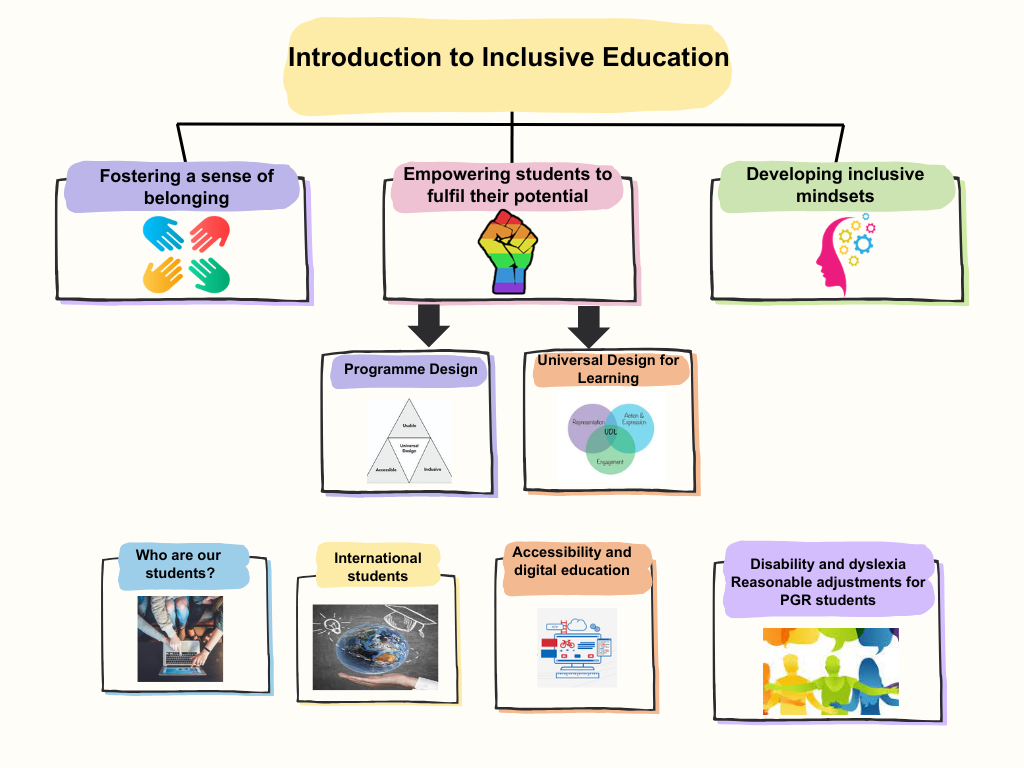Hidden Curriculum
For some students, aspects of institutional practices and processes, and even language, inhibit the development of a sense of belonging. The hidden curriculum refers to the unspoken norms and expectations within academia. These ‘unstated norms, values and beliefs transmitted to students through formal curricular content and classroom social relations’ (Hinchcliffe 2021: 74). Taking these explicit is essential for creating a supportive environment, particularly for first-generation students and other underrepresented groups. Beneficial aspects of the hidden curriculum are seen to be socialisation to a culture and community, and professionalisation, which provide benefits for our wider society and community cohesion. However, the hidden curriculum arguably acts to transmit ideologies as uncontested, taken-for-granted knowledge. There are significant challenges of the hidden curriculum, as it is seen to be the processes of social and cultural reproduction that serve to ensure the ‘preservation of existing social privilege, interests, and knowledge of one element of the population at the expense of less powerful groups’ (Hinchcliffe 2021: 30).
The hidden curriculum impacts at the intersection between student life experiences and university education, as illustrated in Figure 1, below.

Figure 1: The Hidden Curriculum in Higher Education (Hinchcliffe 2021: 74)
Reducing the impact of the hidden curriculum can be done from either a deficit model or an inclusive standpoint. In the deficit model it is the responsibility of the student to adjust to the norms of the university. A more inclusive approach requires the university and its staff to adjust to accommodate the experiences and needs of the student body, and to clearly articulate expectations where necessary, making the hidden curriculum transparent to all students.
Practical strategies for addressing the hidden curriculum:
Transparency in expectations:
- Clear syllabus and assignment guidelines: Providing detailed syllabi and assignment rubrics that outline expectations for performance, assessment criteria, and success strategies can demystify academic standards. Explaining why certain criteria are emphasized can help students better understand how to approach their studies.
- Step-by-step guides for academic skills: Offer accessible resources or workshops that break down essential academic skills, such as critical thinking, research methods, and referencing. These guides can include sample work or model answers to show what successful submissions look like in specific disciplines.
- Office Hours and academic advisor sessions: Encouraging students to meet with teaching staff and advisors can create a safe space for students to seek clarification on expectations, ask questions, or get feedback without judgment. Making office hours welcoming and accessible, for instance by holding them in informal settings or online, can reduce barriers to engagement.
Inclusive communication:
- Avoid jargon and explain academic terms: Using accessible language in your learning material and in your communications (e.g., announcements and emails) helps all students understand academic content. When discipline-specific terms are necessary, provide definitions or offer context to help students grasp the language of the field.
- Glossary of terms and concepts: Creating a glossary of academic terms that students might encounter—such as “formative assessment,” “critical analysis,” or “plagiarism”—can be a valuable reference. This resource can be part of online learning platforms or course packs and regularly updated.
- Use multiple channels for information: Providing information through a mix of formats—written, visual, and oral—ensures that students receive messages in ways that suit different learning preferences. Repeating key messages at different points in the course can help reinforce understanding.
Additional strategies:
- Inclusive assessment practices: Ensuring that assessments reflect diverse learning styles and abilities allows all students to demonstrate their knowledge without being disadvantaged by hidden requirements. This might include offering options for different types of assignments (e.g., presentations, reports, or reflective journals).
- Feedback for growth: Explicitly teaching students assessment literacy and how to interpret feedback and use it for improvement can bridge the gap in understanding. Conducting sessions on how to apply feedback effectively helps students grasp how feedback connects to future academic performance.
- Peer support networks: Facilitating peer study groups or mentorship programmes enables students to support each other in navigating the unspoken norms of academia, share strategies, and collectively work through challenging content.
Student experiences of moving to university
Where Next
Map of Topics
Below is a map of the toolkit and workshop topics, to aid your navigation. These will be developed and added to in future iterations of this toolkit:

You’re on page 3 of 9 Inclusivity theme pages. Explore the others here:
1.Inclusivity and the CU Inclusive Education Framework
2.Introduction to Inclusive education
3. Fostering a sense of belonging
4.Empowering students to fulfil their potential
5.Developing Inclusive Mindsets
6.Universal Design for Learning